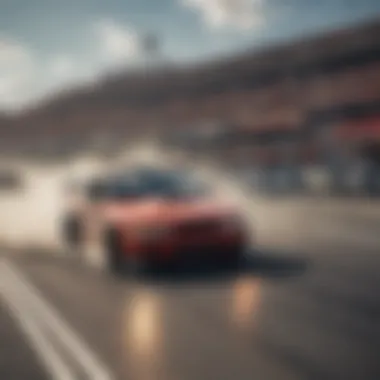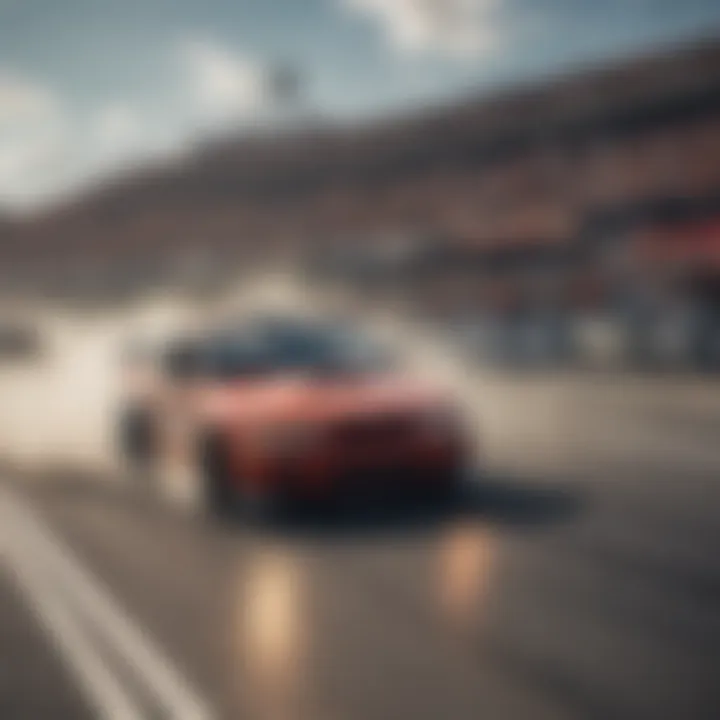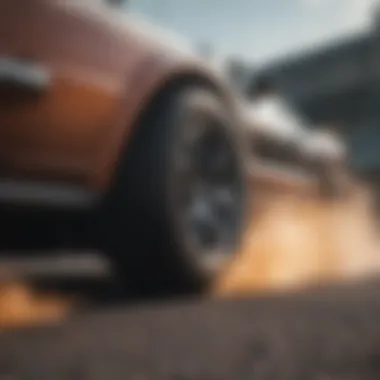The King of Drift: Techniques and Culture Explored


Intro
Drifting, a term that might summon up images of smoke-swirled tires and high-speed turns, is much more than a mere motorsport. It's an art form, a lifestyle, and for many, a culture that weathered adversities to emerge stronger. It all began as a side effect of racing, where drivers needed to maintain speed while navigating sharp corners. Over time, it has blossomed into a thrilling spectacle that captures the hearts of enthusiasts across the globe.
With roots tracing back to Japan’s mountain roads in the 1970s, drifting has evolved into a full-fledged global community. Events like Formula Drift and the D1 Grand Prix showcase not only skill but also the burgeoning culture that surrounds it. From the vehicles that embody the sport to the unique terminologies that fans cherish, drifting's multifaceted nature is what makes it compelling.
In this article, we will delve into the various techniques that separate amateur drifters from the true kings of drift. We’ll examine the gear necessary to excel, prioritize safety, and even take a closer look at the personalities who have defined this sport. Whether you are a seasoned driver or a curious newcomer, this guide will equip you to appreciate drifting from every angle.
As the wheels spin and tires shriek in a symphony of power, let’s get into the heart of the matter: mastering the art of drifting.
Techniques and Tips
Drifting is not just about hitting the gas and hoping for the best. To leave a lasting impression on the track, one must be versed in various techniques and tips that elevate their driving game.
Skill Development
The foundation of any skilled drifter starts with an understanding of vehicle dynamics. These drivers must learn how to control oversteer and understeer while maintaining speed. This often comes down to developing a keen sense of timing and spatial awareness. Regular practice is vital; many start in lower-powered vehicles to hone their skills before transitioning to more powerful machines. Just like a painter starts with strokes before creating a masterpiece, mastery of drifting requires patience and consistent effort.
Practical Techniques
To drift effectively, several methods can be employed:
- Clutch Kicking: This involves quickly pressing and releasing the clutch while accelerating to induce oversteer.
- Handbrake Turn: Pulling the handbrake during a turn can help initiate a drift, especially in tighter corners.
- Power Over: Here, the driver applies throttle during a turn to break traction.
Understanding the nuances of these techniques is crucial. Not every turn can be approached with the same mindset; adapting one’s approach to the unique layout of each track is what distinguishes an average drifter from a master.
Common Mistakes to Avoid
Even seasoned pros make mistakes, but learning from these can prevent many headaches:
- Lacking Speed: Trying to drift at too low a speed often leads to loss of control.
- Oversteering: Excessive turning can result in spinning out. Finding the balance here is key.
- Ignoring Tire Conditions: Old or weathered tires can significantly affect performance, so it pays to prioritize maintenance.
Drifting requires finesse and adaptability. Ultimately, regular practice and self-reflection are vital in pinpointing areas of improvement.
Gear and Equipment
Just as a painter needs brushes and paint, a drifter requires specific gear and equipment to fully excel in their craft.
Essential Gear for Beginners
For those just starting, here are some essential items:
- Helmet: Choosing a DOT-approved helmet ensures safety without sacrificing comfort.
- Gloves: Not only do they offer grip, but they also keep sweat at bay during long sessions.
- Racing Suit: Lightweight and fire-resistant, a suit helps protect against burns in the event of a mishap.
Investing in quality gear may seem daunting, but it pays dividends in the long run. Safety and comfort should never be compromised.
Latest Innovations and Trends
The drifting world is forever evolving. Technologies such as telemetry in drift cars are becoming increasingly prevalent, allowing drivers to gather data on their performance. Moreover, advancements in tire technology have enhanced durability and grip, giving drivers the upper hand during competitions.
Reviews and Comparisons
When selecting gear or vehicles, it's always helpful to consult thorough reviews. For instance, looking at forums on Reddit or Facebook can lead to valuable insights shared by fellow enthusiasts and experts. Watching comparative videos on channels like YouTube also provides real-world perspectives on what works best.
Safety Measures
The heart-pounding excitement of drifting should never come at the cost of safety. Proper measures need to be taken to ensure everyone remains in one piece.
Essential Safety Gear
In addition to a helmet and racing suit, consider investing in:
- HANS Device: This Head and Neck Support device keeps the driver’s head and neck secure during high-impact incidents.
- Fire Extinguisher: A lightweight, easy-to-access fire extinguisher should always be nearby.
Best Practices for Safe Participation
On the track or street, adhere to the following:
- Know Your Limits: Pushing too hard can lead to accidents. Recognize when to pull back.
- Respect Fellow Drivers: Always maintain adequate distance from others to minimize risks.
- Stay Hydrated: It’s easy to neglect hydration during adrenaline-fueled moments, but it's crucial for focus and energy.
Injury Prevention and Management
Despite the best precautions, accidents can happen. Learning how to treat common injuries, such as sprains or abrasions, can be invaluable. Knowing rudimentary first-aid techniques can keep a situation from escalating while waiting for professional help.
Spotlights on Extreme Sports
Diving deeper into extreme sports can expand one's appreciation for drifting.
Featured Sport of the Month
Each month, a different extreme sport shines. For example, this month, we’re taking a look at motocross and its thrilling jumps. Similar to drifting, it also revolves around skill, courage, and the pursuit of adrenaline—perfect parallels to understand the drift culture.
Profiles of Prominent Athletes
Spotlighting notable athletes can provide inspiration and context. Legends such as Ken Block and Daigo Saito, known for pushing boundaries and dazzling audiences, exemplify what true mastery in drifting looks like. Their stories not only represent personal journeys but also serve as a beacon for aspiring drifters worldwide.


Finale
Drifting embodies the thrill of speed, the elegance of control, and a community that thrives on passion. As you venture deeper into this world, remember that every skid and maneuver is a stepping stone. It’s not just about competing; it's about embracing the culture that fuels enthusiasts and fosters deep-rooted friendships. So buckle up and get ready to explore the sensational journey of the king of drift.
Preamble to Drifting
Drifting isn't just a motorsport; it's a dynamic blend of art, precision, and flavored adrenaline that has captured the hearts of many. This section will guide you through the essential elements of drifting, setting the stage for a deeper dive into techniques and culture. Understanding drifting offers numerous benefits—be it enhancing your driving skills, appreciating the craft behind the smoke and speed, or even connecting with fellow enthusiasts who share your passion. With roots that spread wide, drifting is more than just turns and skids; it’s a world where precision meets creativity, offering a thrilling experience that resonates with both drivers and audiences.
Historical Context
The origins of drifting trace back to the winding mountain roads of Japan in the late 20th century. It blossomed from a style of driving known as "touge"—a practice where street racers navigated tight turns at high speeds. Drivers would push their cars to the limit, often sending them into oversteer, which is where the drift was born. This wasn’t merely a reckless endeavor; it was an intricate dance between tires, speed, and control. Drifting culture began to take shape in the 1990s, thanks in large part to pioneers who embraced this technique not just for racing, but as a fundamental part of their identities as motor enthusiasts.
Drifting started to gain traction in various car clubs, where it soon became a celebrated form of expression. Japanese icons like Keiichi Tsuchiya, known as the "Drift King," began showcasing the skill on both the mountains and race tracks, drawing attention from around the globe. As interest surged, so did the opportunities, giving rise to an entirely new genre of motorsport that blended skill, thrill, and a community spirit.
Emergence as a Competitive Sport
Drifting evolved from informal street racing to a structured competitive sport over the years. Events began popping up, transitioning from local gatherings to international competitions. The formation of series such as Formula Drift marked a significant milestone, providing a platform where drifters could showcase their mastery and creativity in a professionally organized atmosphere. These events allowed drivers to not only compete but also to share their passion with thousands of fans, building a vibrant community around the sport.
During competitions, judges evaluate drivers based on various criteria, including line, angle, speed, and overall execution. This structured approach requires drivers to refine their techniques, which helps in pushing the boundaries of what's possible in drifting. It also promotes a sense of camaraderie; drifters often share tips, tricks, and their passion, continuously evolving the sport. Moves that once may have been relegated to the backroads of Japan have now found their way onto the world stage, captivating audiences everywhere.
"Drifting isn’t just about the car; it’s about the driver’s soul coming alive on the asphalt."
The journey of drifting from the backdrop of mountain roads to high-octane competitions tells a story of transformation. Today, it stands as a testament not only to driving skill but to a culture rich in history and camaraderie.
Defining the Drift Technique
Understanding the concept of drifting goes far beyond simply turning the steering wheel sharply while hitting the gas. It embodies a seamless blend of art, physics, and mastery, which together create a unique spectacle. Defining the drift technique is crucial to grasping the very essence of this motorsport. This section sheds light on the importance of specific elements, benefits, and considerations central to the notion of drifting.
Drifting is not merely about losing control; it’s about maintaining composure while guiding the vehicle through a controlled slide. Recognizing the subtleties involved in executing a drift can dramatically affect performance on the track. In detail, these techniques serve as the backbone for not just competitive drifting but also for showcasing skill in everyday scenarios.
Inception of the Drift
Drifting's beginnings might trace back to the winding mountain roads of Japan, where skilled drivers sought to push their vehicles to the limit. Initially rooted in rally racing, the technique evolved into a standalone discipline throughout the late 20th century. Participants took inspiration from the tight corners and unforgiving turns, turning what was once seen as reckless maneuvers into an art form that required a high level of finesse and control.
When racers began to notice that power slides contributed not only to speed but also to style, drifting naturally emerged. Soon, it wasn't only about getting from point A to B, but how spectacularly one could do so.
Key Techniques Explained
Clutch Kick
The clutch kick method is a vital part of a drifter's repertoire. It involves disengaging and then quickly re-engaging the clutch during a turn, sending power to the rear wheels and effectively breaking traction. This technique is celebrated for its immediacy in generating oversteer, allowing the driver to exit corners confidently.
One of the standout characteristics of the clutch kick is its versatility. It can be used in various scenarios, whether initiating a drift on a tight bend or maintaining one at speed. However, it requires precise timing and a delicate touch, making it a beloved choice among seasoned drifters. The advantage here is clear: it provides quick bursts of power, but if miscalculated, can lead to loss of control.
Power Over
Power over is another technique that drifters commonly utilize. Here, the driver exercises control by applying throttle during the onset of a slide. By over-revving the engine as they enter a corner, the rear wheels spin faster than the front, creating an exhilarating slide.
The key feature of power over is its straightforwardness—drivers might find it more intuitive. This method is particularly effective in high-speed scenarios where sheer acceleration helps maintain the slide. While engaging in power over, it’s crucial to manage throttle input closely, as too much can result in uncontrolled spins, leading to unintended consequences.
Scandinavian Flick
The Scandinavian flick, also known as the pendulum turn, represents a technique rich with tradition. Predominantly used in rally racing, it involves a flick of the steering wheel in the opposite direction before entering a turn, effectively setting the car into a slide.
There’s an undeniable charm to the Scandinavian flick—its visual elegance is matched by its efficiency in corners. Drivers appreciate this technique for its ability to transition smoothly between directions, a fundamental aspect of maintaining speed. Nevertheless, its unique feature lies in the fact that it requires a good sense of timing and road position—get it wrong, and the drift could turn into a drift fail, which is never a fun experience.
Vehicles of the Drift King
The vehicles chosen for drifting underpin the entire sport, influencing not only performance but also the very essence of the drifting experience. From the rumble of the engine to the feel of the steering wheel, every detail in a drift car contributes to the broader narrative of control and expression on the track. Selecting the right car is not merely about horsepower; it’s about tuning into the relationship between driver and machine. A well-chosen vehicle becomes an extension of oneself, enabling the nuances of drifting to come alive.
Choosing the Right Car
When it comes to drifting, the right car isn't necessarily a matter of make or model, but rather how well it matches the driver’s personal style and skill level. For beginners, a lighter vehicle often offers better maneuverability, while seasoned drifters may opt for something with a bit more muscle. Common choices tend to include rear-wheel-drive vehicles like the Nissan 240SX or the Mazda RX-7. These cars provide the balance the sport demands, allowing drivers to initiate and sustain those beautiful slides with confidence.
- Balance and Weight Distribution: A car's weight distribution affects how it behaves at high speeds during a drift. Rear-wheel-drive cars typically distribute weight in a way that enhances control.
- Engine Power: While it’s tempting to think of power as the sole determinant, too much can make a car unwieldy for less experienced drifters. Starting with a moderate power setup helps build foundational skills.
- Adjustability: Many drift cars allow for suspension adjustments, permitting drivers to fine-tune handling characteristics to their liking.
Modifications for Optimal Performance
Once the right base is chosen, performance modifications can take a vehicle from good to outstanding. Each component works in harmony to ensure not just power and handling but also safety, which is of utmost importance in any motorsport.
Suspension Upgrades
Suspension upgrades play a pivotal role in establishing handling precision during drifting maneuvers. Upgrading components like shock absorbers and sway bars can provide necessary stability and control. Here are some key points:
- Key Characteristic: A high-performance suspension allows drivers to tune their car's handling to suit their preference, be it tight cornering or long, drawn-out drifts.
- Popular Choices: Coilovers are a favored solution among drifters due to their adjustability, letting drivers alter ride height and dampening levels for optimal performance on varied surfaces.
- Unique Feature: Many coilovers feature independent adjustment options, allowing fine-tuning of spring rate and damping effects separately, which can translate to dramatic improvements in control.
- Advantages / Disadvantages: While effective, these upgrades often come with a stiffer ride, which might be uncomfortable for daily use. However, on the track, they provide the cornering power needed to maintain those perfect angles during a drift.
Tires Selection
Tires form the only contact point between the car and the track, making their selection highly influential in drifting performance. The right tires can significantly enhance grip and control, making it easier to maintain a drift once it’s initiated.
- Key Characteristic: Tires can be chunked into two categories: street and competition. Competition tires often provide a better grip and are designed for warmer conditions, helping in maintaining wide slides.
- Popular Choice: Brands like Falken and Nitto dominate the scene due to their blending of performance and durability under the harsh, repeated stress of drifting.
- Unique Feature: Many tire models designed for drifting feature softer rubbers for better adhesion, though they may wear out quicker compared to standard road tires.
- Advantages / Disadvantages: While high-performance tires improve grip, they can lead to increased wear, meaning they might not be the best choice for everyday use. Finding the balance between street usability and drift performance is crucial.
Engine Modifications
Engine modifications are often seen as the heart of performance tuning in drifting. Enhancements to engine efficiency, power, and reliability can create a formidable drift machine, capable of sustaining high speeds on the track.
- Key Characteristic: Many drifters opt for turbocharging their engines, increasing the power output without significantly altering the vehicle's weight.
- Popular Choice: For those who lean toward V8 power plants, swapping in a Chevy LS engine has become a staple in the drifting community due to its tunable nature and massive torque output.
- Unique Feature: A well-tuned engine can deliver power smoothly across the rev range, crucial for maintaining drifts without abrupt changes that could destabilize the car.
- Advantages / Disadvantages: Turbocharged engines can offer an exciting increase in power, but they also require careful tuning to prevent lag or boost creep, which could negatively impact control during a drift.


Understanding how these modifications interact is vital, as a successful drift relies on the synergy between all components of the car. A poorly matched or inadequately tuned vehicle can result in a loss of control and even accidents, emphasizing the need for comprehensive knowledge and skill.
The Drift Community
Drifting isn’t just a motorsport; it’s a vibrant community of enthusiasts who share a passion that extends beyond tires screeching and engines roaring. The social aspect of drifting plays a pivotal role in cultivating a culture where drivers, fans, and spectators connect. Together, they foster camaraderie, celebrate achievements, and face challenges in their pursuit of mastery.
Cultural Significance of Drifting
Drifting has woven itself into the very fabric of modern car culture. This motorsport transcends geographic borders, attracting a diverse following. It embodies individuality and style, allowing drivers to showcase their personalities through driving techniques and vehicle modifications. The grassroots movements often start with local meetups, where drivers share tips, tricks, and basic drifting techniques with newcomers. In many ways, these gatherings feel like family reunions.
This culture underlines a few essential elements:
- Inclusivity: Everyone from novices to seasoned veterans can participate, learn, and grow together.
- Creativity: Drivers often express their artistic flair through their vehicle aesthetics, preferring unique paint jobs or customized body kits that represent their identity.
- Respect for Tradition: Older drivers often mentor youths, creating a lineage of knowledge that helps preserve drifting’s rich history while encouraging innovation.
Often, drifting events serve as local festivals, with food trucks, vendor booths, and music, making them attractive to even those not focusing on cars. This wider appeal helps strengthen ties within the community.
Global Drift Events
Drifting’s thrilling nature is amplified on the global stage through various events where the best of the best come to compete. Here is a look at some notable platforms:
Formula Drift
As one of the premier drifting competitions in the world, Formula Drift has grown from a niche event to a global phenomenon. This league features professional drifters who compete on intricate tracks designed to test their skills to the limit. The exhilarating spectacle not only draws massive crowds but also generates significant media attention. Formula Drift stands out for its heavily regulated competition format that insists on safety while pushing drivers to unleash their skills.
The unique scoring system differs from other motorsport events, focusing on style, angle, and speed rather than mere finishing position. This aspect helps shift the emphasis from being a 'winner-takes-all' scenario to appreciating the artistry within each run.
D1 Grand Prix
Similar to Formula Drift but with its rhythm, the D1 Grand Prix is a cornerstone in the drifting world that highlights a more traditional approach to the sport. Originating in Japan, it remains a tribute to drifting's roots. Events are often lauded for their authentic vibe, where spectators can truly engage with drifters and their vehicles. What makes the D1 Grand Prix significant is its diverse locations and varied layouts, enabling drivers to demonstrate flexibility and adaptability.
Furthermore, the D1 Grand Prix draws a different crowd. The spectators here often harbor a deep appreciation for drifting's intricate history, making it a beloved event among purist fans. This can also lead to a disconnect with newer, flashier events, showcasing a rift sometimes found within the drifting community.
Local Showdowns
On the grassroots level, Local Showdowns are crucial in nurturing the next generation of enthusiasts. These events are often less formalized than larger competitions but brim with energy and potential. They typically feature drivers from nearby areas battling it out in a friendly, yet competitive, atmosphere. These contests provide a fantastic platform for drivers to hone their skills in a more supportive environment.
Local Showdowns help build community ties as participants and onlookers develop personal connections, making memories that often last a lifetime.
"The joy of drifting lies not just in the tire smoke but also in the friendships forged in the process."
In essence, the drift community thrives on collaboration, whether through competitive events or local meetups. Whether you’re attending a grand show or a local showdown, the connections formed often become the gears that keep the drift culture rolling.
Profiles of Acclaimed Drifters
In the realm of drifting, the individuals who command the respect and admiration of fans and peers alike are known as the drifters themselves. Their skills, personalities, and unique styles contribute significantly to the sport’s culture and growth. This section aims to bring attention to some of the most iconic figures in drifting, showcasing their influence, achievements, and the distinctive qualities that set them apart. Through these profiles, readers will gain a deeper appreciation for not only the art of drifting but also the community it fosters.
Iconic Figures in Drifting
Ken Block
Ken Block is a name synonymous with excitement in the world of motorsports. Known for his daring and unpredictable stunts, he has elevated drifting beyond mere competition. Block’s Gymkhana series brought drifting into the limelight, drawing a broader audience who may not have otherwise been interested in motorsports.
One of Block’s key characteristics is his exceptional creativity. He doesn't just drift; he tells a story through his driving, weaving intricate maneuvers seamlessly into captivating visuals. This not only entertains but educates aspiring drifters on the importance of style in addition to skill.
A unique aspect of Ken Block is his ability to cross over into various motorsport disciplines, further popularizing drifting. His partnership with brands like Hoonigan has made drifting more accessible, providing resources for those looking to dip their toes into this thrilling sport. However, some traditionalists argue that his flashy style overshadows the technical aspects of drifting, creating a divide in how drifting is perceived. Still, his impact on the sport is undeniable and remains a focal point of discussion.
Taka Kubo
Taka Kubo, hailing from Japan like many great drifters, has had a considerable impact on the global drifting scene. His precision and smooth driving style make his runs thrilling to watch. Kubo stands out for his commitment to pushing the boundaries of what is possible in a drift.
The key characteristic of Kubo is his strong ties to drifting heritage. He embodies the spirit of traditional Japanese drifting while also embracing modern techniques, serving as a bridge for new drifters seeking to understand the sport’s roots.
What sets Kubo apart is his mentoring approach. He actively engages with younger drifters, encouraging them to preserve the culture and commit to their craft. This has created a supportive community that values skill, respect, and history. However, some might say his focus on cultural elements might limit his appeal to a younger audience that values spectacle and excitement.
Chris Forsberg
Chris Forsberg is a standout figure in the American drifting scene, recognized for his technical skill and strategic mindset during competitions. Championing the Formula Drift series multiple times, Forsberg represents determination and the ability to adapt to the evolving world of motorsports.
Forsberg’s key characteristic is his analytical approach to drifting. He often takes the time to study competition footage, providing insights into strategies that can be applied to different tracks. This analytical mindset has garnered him respect not just as a competitor but also as a teacher, making him a beneficial asset in sharing knowledge about the sport.
A defining feature of Forsberg’s style is his impressive consistency. He rarely falters during events, exhibiting both control and speed, which are crucial in competitive drifting. Still, this relentless pursuit of perfection can sometimes lead to pressure, pushing him to make choices against instinct during high-stakes moments.
Pioneers of Drift Culture
Drifting wouldn't be what it is today without the pioneering figures who laid the groundwork for this lifestyle. These individuals have contributed to not only the techniques and events associated with drifting but also the broader culture that surrounds the sport. Their stories and legacies serve to inspire the current and future generations of drifters, ensuring the art of drifting continues to evolve while respecting its deep roots.
Safety and Training in Drifting
Drifting, while exhilarating, is not without its risks. As speed, precision, and control intertwine in this motorsport, the need for safety becomes paramount. Embracing proper training and understanding safety protocols not only enhances performance but also minimizes potential hazards. Every drifter, regardless of experience level, should grasp these foundational elements to enjoy the thrill while keeping themselves and others safe.
Understanding Risks and Precautions
Before hitting the track, it is crucial to recognize the various risks that come with drifting. High speeds, sharp turns, and vehicle control challenges can lead to accidents if not managed correctly. Effective risk management starts with wearing proper safety gear, such as helmets, gloves, and racing suits that meet safety standards.
Another vital precaution is the preparation of your vehicle. This includes regular inspections of brakes, tires, and oil to avoid mechanical failures. Additionally, making sure you have a fire extinguisher within reach can be a lifesaver in emergencies. Understanding these factors equips drivers to tackle potential problems head-on.


"Safety isn't just a rule, it's a mindset that ensures the drift remains a thrill, not a tragedy."
Training Schools and Resources
For those eager to dive into the world of drifting, various training options exist that cater to different learning preferences. Each offers unique advantages, whether you’re a complete beginner or someone looking to hone your skills further.
Drift Clinics
Drift clinics are specialized training sessions, often held at racetracks, designed to teach the fundamentals of drifting. They provide hands-on instruction where experienced drifters share their expertise. Many clinics incorporate timed runs and simulations, giving participants real-time feedback, which is a fantastic way to improve.
One of the keys that set drift clinics apart is the ability to learn on actual tracks rather than in the streets. This controlled environment allows for safety and minimization of risk for both learners and the public. However, they can be costly, depending on the clinic and duration.
Online Tutorials
In today’s digital world, online tutorials have become a popular way for aspiring drifters to learn at their pace. These resources range from YouTube videos to dedicated online courses. They cover topics like the basics of car control, advanced drifting techniques, and safety measures.
The primary strength of online tutorials is accessibility. Anyone with internet can benefit from them. However, the lack of practical application means that learners might miss out on the hands-on experience essential for mastering the craft. So, supplementing online learning with actual practice is crucial.
Local Workshops
Local workshops can be another effective vehicle for training. Typically organized by car clubs or community groups, these workshops focus on community engagement and hands-on learning. Participants often work with experienced instructors and fellow enthusiasts to practice techniques in a supportive environment.
The social aspect of local workshops not only fosters camaraderie but also creates opportunities for networking within the drifting community. However, the availability of workshops may be inconsistent, depending on the region, which can limit access for some individuals.
In summary, whether through drift clinics, online tutorials, or local workshops, engaging in some form of training is vital for any drifter. A solid foundation in safety and skill development ensures the ride stays thrilling and helps build a vibrant community around this captivating sport.
Drifting as an Expression of Art
Drifting, at its core, isn't merely a display of skillful car handling; it transcends basic mechanics and delves into a realm of creativity and aesthetics. The vibrant culture surrounding drifting weaves together technical prowess with artistic expression. For enthusiasts and participants alike, drifting becomes a canvas—where every turn, every slide and every burst of speed reflects a unique style and personality. This idea is vital for understanding the broader implications of the sport, as well as its deep-rooted cultural significance.
The importance of recognizing drifting as an art form lies in its capacity to challenge traditional perceptions of motorsports. It is not strictly about competitive racing or timed events; rather, each drift is a spontaneous moment, an improvisation that blends intuition and technique. This experience allows drivers to share their stories—letting their vehicle express individuality through furious spins and ghosting rubber on the asphalt.
The Aesthetic of Drift
Visually, drifting creates a spectacular scene. The combination of speed, smoke, and grace can only be described as mesmerizing. A well-executed drift embodies an almost poetic choreography, where the driver dances with the vehicle. The angles, the flow of the car’s body in motion, each contribute to a specific visual language. Drifters often find inspiration in different elements:
- Dynamic Lines: As cars arc through turns, they create sweeping lines on the track that can be aesthetically appealing.
- Smoke Trails and Tire Marks: The way tires break loose and create clouds of smoke adds a raw, untamed beauty to drifting.
- Soundscape: The roar of engines, the screeching of tires, and the rhythm of acceleration all form an auditory backdrop that complements the visual spectacle.
So, to the keen observer, drifting is not just about speed; it’s an artistic expression that speaks of passion, identity, and an intrinsic understanding of both the vehicle and the environment.
Drift Photography and Videography
With the aesthetics of drifting captured through photography and videography, this art form gains even more depth. The lens serves as a bridge between creativity and the adrenaline-fueled world of motorsports. When taking photographs or filming drift events, several key factors come into play that ensure the essence of drifting is preserved:
- Timing and Perspective: Capturing a drift at just the right moment can convey motion and intensity. Choosing low angles can enhance the sense of speed.
- Lighting: Different times of day create varied effects. A setting sun can bathe the scene in golden hues, making tire smoke look more dramatic.
- Editing Techniques: Skilled editors often use fast cuts, slow motion and color grading to emphasize the excitement and artistry of drifting.
Drift photography and videography not only serve to immortalize the sport but also contribute to its culture. They inspire new generations to pick up camera gear just as others may pick up the steering wheel. By sharing breathtaking images and videos on platforms such as Reddit, and Facebook, the drifting community spreads its appreciation for the aesthetic beauty inherent in the sport.
"Drifting is like painting with cars; every slide, every sketch in tire smoke, breathes life into the canvas of the tarmac."
Recognizing drifting as an art form thus brings a fresh perspective that resonates deeply within the community while enriching the experience for both participants and spectators.
Future Trends in Drifting
The world of drifting is not just an adrenaline-fueled spectacle; it is a constantly evolving sport that embraces innovative technology and adapts to societal shifts. As we navigate through the rapidly changing landscape of motorsports, it’s crucial to recognize the upcoming trends that will shape drifting's future, both in practice and perception. Understanding these developments will help enthusiasts stay ahead of the curve, ensuring that they are not just spectators but active participants in this exhilarating journey.
Technological Innovations
The role of technology in drifting cannot be emphasized enough. From enhancements in vehicle performance to advancements in safety equipment, such innovations are transforming the way drivers approach the sport.
- Simulation Training: With programs like iRacing and Assetto Corsa, technology allows drivers to hone their skills in a virtual environment. These simulators have become remarkably realistic, allowing for real-time feedback and data analysis, helping drivers prepare for the track.
- Data Analytics: Many professional teams are now using telemetry data to refine their techniques. By analyzing variables like tire temperature and suspension dynamics, drift teams can make informed decisions to optimize their vehicles’ performance for each event. This data-driven approach has become essential to maintain an edge on competitive stages.
- Electric and Hybrid Drifting: As environmental concerns escalate, the drifting community is turning towards sustainable alternatives. Electric powertrains are gaining traction in motorsports, with companies like Rimac and Tesla leading the charge. An electric drift vehicle, such as the Tesla Model S, not only boasts instant torque but also provides unique challenges related to weight distribution and control. The shift toward hybrid engines could usher in a new era of drifting, one where eco-friendly practices can coexist with thrilling pursuits.
"The transition to electric vehicles in drifting may redefine how we understand vehicle dynamics and strategy—change is the only constant." - Anonymous Drifter
Environmental Considerations
As the culture of drifting continues to grow, so does the responsibility towards environmental stewardship. Here are some elements that highlight the increasing awareness:
- Reducing Carbon Footprint: Drifters and event organizers are beginning to adopt eco-friendly practices. This includes using synthetic fuels and promoting low-emission vehicle entries, minimizing the sport’s environmental impact. Brands like BMW and Ford are exploring sustainable materials for vehicle production, which presents an excellent opportunity for innovation in vehicle design.
- Event Management: Events have also started to focus on greener practices. By implementing recycling initiatives, reducing waste, or using renewable energy sources for infrastructure, drifting events can align with broader environmental goals. This kind of awareness not only resonates with participants but also with spectators, encouraging a healthier approach to motorsports.
- Community Engagement: The drifting community is actively participating in local environmental initiatives. Collaborations between drift clubs and environmental organizations aim to raise awareness and promote sustainability within the thrill-seeking community. Not only are such initiatives vital for community relations, but they also bring a deeper sense of purpose to the sport.
Integrating these trends into the ethos of drifting doesn't just enhance performance; it also cultivates a healthier relationship with our planet. As the sport embraces these forward-thinking concepts, it creates an aspirational model for future generations.
Culmination: The Legacy of the Drift King
In wrapping up our exploration of drifting, it becomes clear that this motorsport holds a unique place in both the automotive world and broader culture. The legacy of those known as the “Drift King” is multifaceted, representing not just a mastery of technique, but also a deep-seated influence on the evolution of racing in general, and how we perceive vehicle performance.
The essence of drifting transcends mere competitive sport; it embodies creativity, skill, and community. Drifters harness their vehicles to create spectacular displays of control, balancing chaos and precision. This art form not only captivates spectators, but serves as a powerful means of expression, echoing the often intricate relationship between humans and machines.
Enduring Influence on Motorsports
The impact of drifting on motorsports is undeniable. Initially considered a fringe activity, drifting has evolved into a cornerstone of contemporary motorsport culture. From grassroots meets to high-stakes competitions, it has influenced driving styles, car designs, and even the lengths manufacturers go to in terms of performance enhancement.
Key areas where drifting has shaped motorsports include:
- Vehicle Customization: Drifting has pushed enthusiasts to innovate, resulting in astonishing vehicle modifications. These changes often extend far beyond aesthetics and focus on performance and handling.
- Racing Formats: The emergence of events like Formula Drift popularize competition formats that place emphasis on style, angle, and speed rather than traditional timing alone.
- Broader Appeal: Drifting has brought a more inclusive atmosphere to motorsports, attracting a diverse range of individuals, from seasoned racers to casual fans.
Encouraging New Generations of Drifters
As the drifting community continues to expand, it's crucial to foster and inspire the next generation of drifters. Various factors play a significant role in this development:
- Access to Resources: With the rise of online tutorials, drift clinics, and local workshops, aspiring drifters have more opportunities to learn than ever before. This access allows novices to gain the skills they need, sometimes right from their living rooms.
- Community Building: Drift weekends and local meetups become hubs of knowledge sharing. Here, veterans and novices mingle, exchanging tricks of the trade and fostering friendships through a mutual passion.
- Diversity in Events: From small local events to grand international competitions, the variety of platforms available encourages participation. No longer confined to closed circuits, drifting has made its way to urban landscapes and unregulated spaces, thereby inviting the adventurous spirit in everyone.
"Drifting isn’t just about the tires, it’s about steering in a way that connects your heart and mind to the asphalt beneath you."







